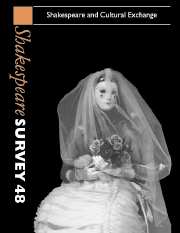Book contents
- Frontmatter
- Shakespeare Translation as Cultural Exchange
- Shakespeare, Theatre Production, and Cultural Politics
- ‘Amphitheaters in the Body’: Playing with Hands on the Shakespearian Stage
- ‘Shakespur and the Jewbill’
- Wilhelm S and Shylock
- Pilgrims of Grace: Henry IV Historicized
- Holy war in Henry V
- Hamlet and the Anxiety of Modern Japan
- Hamlet’s Last Words
- Venetian Culture and the Politics of Othello
- ‘My Music for Nothing’: Musical Negotiations in The Tempest
- The Tempest and Cultural Exchange
- Caliban and Ariel Write Back
- Shakespearian Rates of Exchange in Czechoslovakia 1945–1989
- ‘Are you a Party in this Business?’ Consolidation and Subversion in East German Shakespeare Productions
- The Martyred Knights of Georgian Shakespeariana
- Shakespeare Performances in England, 1993–1994
- Professional Shakespeare Productions in the British Isles, January – December 1993
- 1 Critical Studies
- 2 Shakespeare’s Life, Times, and Stage
- 3 Editions and Textual Studies
- Books Received
- Index
Holy war in Henry V
Published online by Cambridge University Press: 28 March 2007
- Frontmatter
- Shakespeare Translation as Cultural Exchange
- Shakespeare, Theatre Production, and Cultural Politics
- ‘Amphitheaters in the Body’: Playing with Hands on the Shakespearian Stage
- ‘Shakespur and the Jewbill’
- Wilhelm S and Shylock
- Pilgrims of Grace: Henry IV Historicized
- Holy war in Henry V
- Hamlet and the Anxiety of Modern Japan
- Hamlet’s Last Words
- Venetian Culture and the Politics of Othello
- ‘My Music for Nothing’: Musical Negotiations in The Tempest
- The Tempest and Cultural Exchange
- Caliban and Ariel Write Back
- Shakespearian Rates of Exchange in Czechoslovakia 1945–1989
- ‘Are you a Party in this Business?’ Consolidation and Subversion in East German Shakespeare Productions
- The Martyred Knights of Georgian Shakespeariana
- Shakespeare Performances in England, 1993–1994
- Professional Shakespeare Productions in the British Isles, January – December 1993
- 1 Critical Studies
- 2 Shakespeare’s Life, Times, and Stage
- 3 Editions and Textual Studies
- Books Received
- Index
Summary
Joel Altman calls Henry V ‘the most active dramatic experience Shakespeare ever offered his audience’. The experience climaxes at the end of the final battle with the arrival of news of victory. Here the King orders that two hymns be sung while the dead are buried, the ‘Non Nobis’ and the ‘Te Deum’. In his 1989 film, Kenneth Branagh underlines the theatrical emphasis of this implicit stage direction. He extends the climax for several minutes by setting Patrick Doyle’s choral-symphonic rendition of the ‘Non Nobis’ hymn behind a single tracking shot that follows Henry as he bears the dead body of a boy across the corpse-strewn field of Agincourt. The idea for this operatic device was supplied by Holinshed, who copied it from Halle, who got the story from a chain of traditions that originated in the event staged by the real King Henry in 1415. Henry himself took instruction from another book, the Bible.
The hymns which Henry requested derive from verses in the psalter. 'Non Nobis' is the Latin title of Psalm 115, which begins, 'Not unto us, O lord, not unto us, but unto thy Name give the glory . . .' This psalm celebrates the defeat of the Egyptian armies and God's deliverance of Israel at the Red Sea. It comes midway in the liturgical sequence known as The Egyptian Hallelujah extending from Psalm 113 to 118,a sequence that Jesus and the disciples sang during the Passover celebration at the Last Supper and that Jews still recite at all their great festivals.
- Type
- Chapter
- Information
- Shakespeare Survey , pp. 85 - 98Publisher: Cambridge University PressPrint publication year: 1996
- 1
- Cited by

